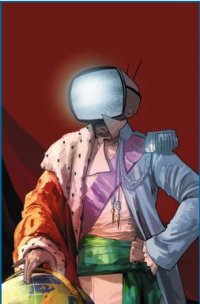Concrete: Three Uneasy Pieces ($2.99, Dark Horse)
By D.S. Randlett (@dsrandlett)
Confession time: I had never read one word of Paul Chadwick’s Concrete until today. It’s been recommended to me often, and I’ve seen past miniseries listed on many an “essentials” list. I even remember seeing it recommended in Wizard magazine back when that was a thing, but I was also far too young to really get it. I remember liking the design of the title character, but being confounded by whatever cover image they would choose to represent the series. Here was this superheroey character doing decidedly non superheroey stuff, usually gazing with his trademark friendly stare at the reader while surrounded by members of his supporting cast.
The release of this collection of three short stories from the superlative Dark Horse Presents seemed to me as good a chance as any to remedy any youthful indiscretions. I’m glad that I waited, as Chadwick presents these stories with a sense of lyricism that I don’t think would have registered with me as a child. As brief as this collection is, the whiff of a distinct creative voice is absolutely palpable. As a result, these brief stories are not simply read, but felt.
The first story is the strongest of the bunch, and it positions Concrete as an honest to God superhero. This is a book that doesn’t seek to deconstruct, but rather it gets at what makes superhero stories great when they operate in the realm of honesty. This is particularly manifest in the first story, which blends the title character’s meditations on women and relationships with an incident that requires his talents. It is at once dark and sweet, and this story alone makes me want to explore this world more. The other two stories aren’t too shabby, either, but they might be more rewarding for longtime readers of Chadwick’s creation.
Something that I found refreshing about Concrete himself is that he doesn’t seem to be a “cause and effect” sort of hero. His origin doesn’t seem to center around a mistake or tragedy that imbued him with a sense of purpose. He’s just a fundamentally decent guy, and it’s the struggles of being decent that are have been at the heart of superhero fiction since its inception in 1938.
Chadwick’s art also pops. There are all sorts of delightful Kirbyisms and imagery that hearkens back to Universal monster movies, but it’s all grounded in a perfectly believable mundane world. Chadwick has a gift for the eyes, and obvious asset when it comes to his mostly featureless main character, but it also helps him to imbue hsi supporting characters with a sense of humanity in comic book art.
So yeah, consider me a convert.
Rating: 




Out of a Possible 5 Stars
 Captain Marvel #1 (Marvel, $2.99)
Captain Marvel #1 (Marvel, $2.99)
By Jeb D.
It’s hardly news that superhero comics have long used female characters for sexual titillation as much as (more than?) anything else, but even in that context, Ms Marvel’s costume, with the stripper’s bareass cutaway and dominatrix’s opera gloves, really stood out for its blatancy. In launching Carol Danvers into her new series, writer Kelly Sue Deconnick addresses that one right out of the gate in a cheekily offhand manner: the title splash page shows Carol in her new, less revealing (though, naturally, still skintight) costume, with an inset of an ad promoting an in-story charity auction of the old costume. And that’s a nice hint as to Deconnick’s direction for the series: respecting the superhero tropes that have gone before, and working to turn the corner away from the more negative ones, rather than simply pulling a quick U-turn.
This new series, which sees Danvers accepting the “official” Captain Marvel mantle, is the culmination of the character’s throughline going back at least to Alias: it’s not that much of a reach to see Danvers’ role in the Marvel U as reflective of the many challenges facing any woman seeking a leadership role in the workplace (see the furor around the pregnancy of new Yahoo CEO Marissa Mayer, as just one example): has she “earned” her place in the spandex pantheon? Is she held to different standards? Should she demand more of the life than flying and punching, or does she have just as much right to the role of “adrenaline junkie” as any of her musclebound male compatriots?
Deconnick gets quite a bit of exposition into a briskly-moving first issue: Danvers and Captain America take on the Absorbing Man, with a level of banter that is the hallmark of great “old-school” superhero writing: witty, but never over-the-top, and she effectively conveys the affectionate military camaraderie inherent in their respective roles. As the story progresses, she manages to bring us the reflective side of Danvers without slowing things down, or piling the panels high with thought balloons. From there, Deconnick moves through the difficult choices involved in Carol’s stepping into Mar-Vell’s space booties, shows us the exhilarating highs and crashing lows of the life of the cosmic adventurer, and introduces the supporting cast, returning Tracy Burke to Carol’s life in a poignant manner, as well as placing Carol’s history into the context of the exploration/militarization of space with a connection to the real “Mercury 13” female astronaut program.
Artist Dexter Soy’s contribution is a bit more problematic, and I suspect that’s largely due to his relative inexperience (he was a recent find of Marvel talent scout C.B. Cebulski). His style is bursting with energy (the fight between the two “Captains” and the Absorbing Man is as kinetic as it is witty), he knows how to register emotion with posture, and the quieter sections of Carol in conversation are often sweetly appealing. But if his range is great, his consistency isn’t: physical proportions sometimes feel distended and inconsistent, facial expressions are sometimes dark and offputting for no obvious reason, and the rather muddy digital production isn’t doing his rugged linework any favors (his style is pretty much the polar opposite of Ed McGuiness’ bright, pop-art cover). It’s certainly not a deal-breaker (though it docked this issue at least half a star for me), but I’m hoping that, if he stays on the book, he can begin the maturing process sooner, rather than later.
The Big 2’s mania for rebranding, repurposing, reintroducing, and rebooting characters has become so omnipresent that it’s scarcely worth comment anymore; it’s definitely rare to find a new #1 book like this one, that actually validates the idea: it takes a viable legacy character, finds ways to explore her history while moving forward, and tells an engaging story in the process.
Rating: 




Out of a Possible 5 Stars
Saga #5 ($2.99, Image)
By D.S. Randlett (@dsrandlett)
I’m starting to think that world-building is an overrated aspect of the appeal of genre fiction. There are many scifi and fantasy books that are almost entirely devoted to explaining their worlds and their rules, and the chief pleasure of many of these books is to see how these rules play out. The refreshing thing about Saga is that it eschews this approach, revelling in a world that conforms to the feeling that writer Brian K. Vaughn and artist Fiona Staples seek to bring out. This world exists for the reader, the only rule seeming to be whatever enhances the book’s themes or tone. If most author’s approach to world building is a form of escapism, Saga’s is a form of confrontation.
There is a purpose to all of this glorious riot, however. Saga is shaping up to be a book about sexuality and parenting. It seems like every character has a kid, is about to have a kid, or else is madly in love with someone. The book seems to posit that the emotions that belong to this milieu are big, messy, painful, and worth it. If love and sexuality in popular fiction has been too subdued over the centuries (think BBC style period dramas), here it seems that we have an inevitable boiling over. Saga is romance and parenthood in its punk rock phase.
Vaughn’s writing is pretty consistently hilarious. I complain a lot about people aping Joss Whedon’s style, but they typically just lift the surface elements of snark and snappish pace without examining what’s underneath them that makes Whedon’s scripts work. Vaughn is an accomplished writer of snark, but much like Whedon, his snark comes from a very honest place. In effect, Vaughn’s humor is more than just skin deep, especially here. In the past, he’s used humor to make his characters likable, but here he deftly expresses how absurd loving and parenting can feel.
Fiona Staples’ art captures Vaughn’s voice quite well. Her cast seems like it’s always in on the joke, and this has far from a distancing effect. Her style puts me in the mind of the second half of Chungking Express, which is perfect for the feelings that this series is exploring.
Most importantly, it finally feels as if the plot is coming together. While the chaotic feel of the book has been exhilarating these past few months, the story that it’s had to tell has felt very straightforward and not terribly compelling. There have been some recent wrenches thrown into the characters’ lives, particularly the not-quite-villain bounty hunter dubbed The Will, who made a very rash decision in the last issue. He seeks some help from an old friend, but it’s fairly obvious that no help will be forthcoming by the issue’s end. Until now, I’ve been interested in Saga as an aesthetic experience, but with its fifth issue it seems that Vaughn has found a voice for the plot as well as his concerns. After five months, Saga has earned its prerelease excitement.
Rating: 




Out of a Possible 5 Stars